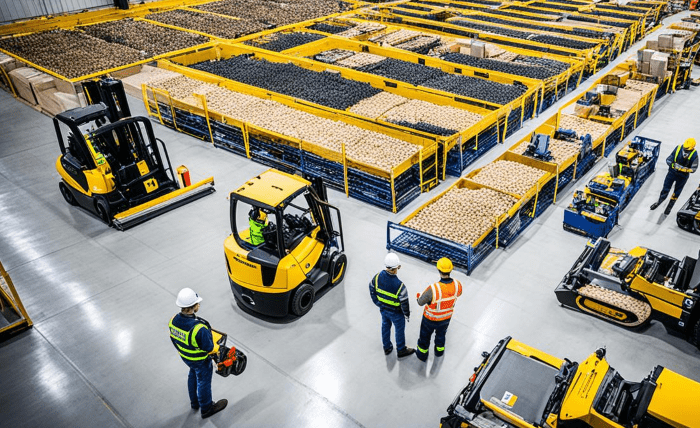
Warehouses are the backbone of supply chains, storing and distributing goods that keep businesses running. Yet, they can also be high-risk environments if safety and compliance measures are overlooked. From heavy machinery to stacked inventory, every aspect of warehouse operations carries potential hazards. Ensuring a safe, compliant warehouse is not only a legal requirement—it also protects employees, boosts efficiency, and reduces costs associated with accidents. This ultimate guide covers essential strategies for maintaining warehouse safety and meeting compliance standards.
Understanding Warehouse Safety
Warehouse safety involves proactive measures to protect employees from accidents and injuries. Common hazards include slips, trips, and falls; forklift accidents; falling objects; and ergonomic strain from repetitive tasks. Many of these incidents are preventable through proper training, equipment, and workplace organization.
The first step in ensuring safety is identifying risks. Conduct a thorough inspection of the warehouse, focusing on areas like storage racks, loading docks, and walkways. Document hazards, evaluate their severity, and prioritize corrective actions. Regular risk assessments should be a part of your safety culture, not just a one-time checklist.
Key Safety Measures
1. Employee Training
Training is the cornerstone of warehouse safety. Employees should receive instruction on proper equipment handling, emergency procedures, and safe lifting techniques. Forklift operators, for instance, must be certified and regularly evaluated. Safety training should be ongoing, incorporating refresher courses and updates when procedures or equipment change.
2. Personal Protective Equipment (PPE)
Providing and enforcing the use of PPE is essential. Helmets, gloves, high-visibility vests, and safety shoes protect workers from injuries that could otherwise lead to severe consequences. Make sure PPE is in good condition and appropriate for the tasks being performed.
3. Equipment and Machinery Safety
Forklifts, conveyors, and pallet jacks are common in warehouses, but they can be dangerous if misused. Regular maintenance checks and clear operating procedures are vital. Lockout/tagout systems should be in place to prevent accidental machine startups during maintenance.
4. Fire Safety and Emergency Preparedness
Warehouses, particularly those storing flammable materials, are at high risk of fires. It’s essential to have fire extinguishers readily accessible and ensure all employees are familiar with evacuation routes. Regular fire drills and clearly marked emergency exits are crucial for preparedness. Working with an experienced industrial electrician in Michigan can help design and maintain proper electrical systems and safety mechanisms, ensuring a comprehensive emergency response plan that minimizes injuries and property damage during a crisis.
5. Ergonomics and Workstation Design
Repetitive tasks and heavy lifting can lead to musculoskeletal disorders. Use ergonomically designed tools, adjustable workstations, and mechanical aids to reduce strain. Encourage employees to take breaks and rotate tasks to avoid overexertion.
6. Proper Storage and Housekeeping
Cluttered aisles, unstable racks, and improperly stored materials are leading causes of warehouse accidents. Maintain organized storage areas, secure shelving, and clearly marked walkways. Regular housekeeping prevents slips, trips, and falls while improving operational efficiency.
Compliance Considerations
Warehouse safety isn’t just about protecting employees—it’s also a legal obligation. Regulatory bodies such as OSHA (Occupational Safety and Health Administration) in the U.S. set standards for workplace safety. Compliance involves adhering to these regulations, documenting safety protocols, and keeping records of training and inspections.
Failing to comply can result in fines, legal liability, and reputational damage. Beyond legal risks, non-compliance can lead to increased insurance premiums and operational disruptions. Implementing a formal safety management system helps ensure continuous compliance and demonstrates a commitment to worker well-being.
Building a Safety-First Culture
Safety should not be treated as a checklist—it must be embedded in the warehouse culture. Encourage employees to report hazards, recognize safe practices, and participate in safety committees. Leadership should lead by example, prioritizing safety over speed or convenience.
A strong safety culture improves morale, reduces turnover, and ultimately enhances productivity.
Leveraging Technology
Modern warehouses can enhance safety and compliance through technology. Automated inventory systems reduce manual handling, while wearable sensors monitor worker health and movement. AI-driven safety cameras detect unsafe behaviors, alerting supervisors before incidents occur. Investing in these tools not only improves safety but also streamlines operations.
In Conclusion
Warehouse safety and compliance are critical for protecting employees, ensuring smooth operations, and meeting legal obligations. By identifying hazards, training staff, providing PPE, maintaining equipment, and fostering a safety-first culture, businesses can significantly reduce accidents and associated costs. Compliance isn’t just a requirement—it’s an investment in your workforce and operational success. Regular reviews, audits, and technological upgrades will help maintain a safe, efficient, and legally compliant warehouse for years to come.




